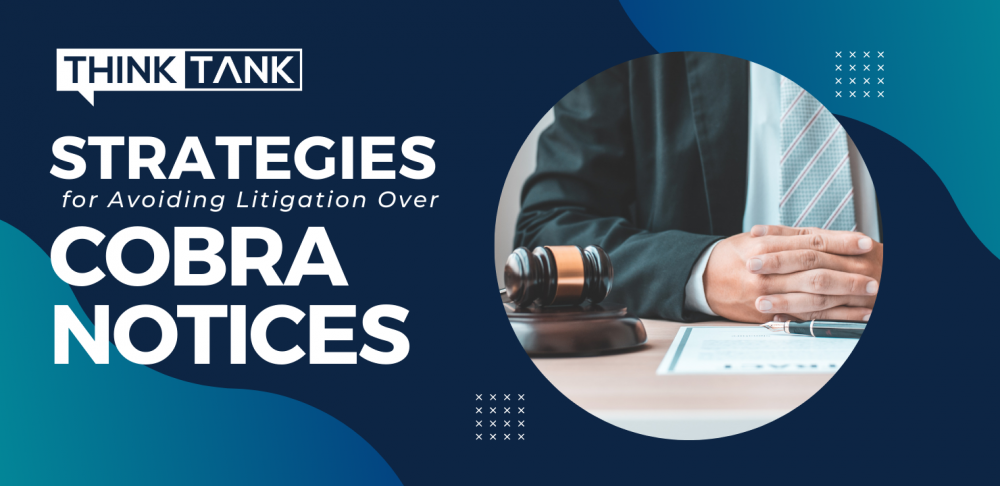Existing Client? Login
Article
Strategies for Avoiding Litigation Over COBRA Notices

Employers are seeing an increase in lawsuits from former employees alleging deficient Consolidated Omnibus Budget Reconciliation Act (COBRA) election notices. These lawsuits are generally class actions and can result in significant attorneys' fee awards for successful ex-employees. Understanding current COBRA notice regulations and litigation trends can help employers stay compliant and avoid costly lawsuits.
What Is a COBRA Notice?
Most employer-sponsored group health plans must comply with the Employee Retirement Income Security Act (ERISA), which establishes standards for protecting employee benefits. One protection established by ERISA is an employee's right to continued health insurance coverage under COBRA.
COBRA allows former employees and their families to continue their health insurance for a limited time after a qualifying event. Qualifying events include:
- Termination of employment
- Reduction of work hours for reasons other than misconduct
- Death
- Medicare eligibility
- Divorce
- A child's loss of dependent status
Employers must provide former employees with notice that they may elect to continue their health coverage.
Why Has COBRA Notice Litigation Increased?
Employers' difficulty in complying with election notice requirements plus the trend of lucrative class action lawsuits seem to be causing the increase in litigation. Although COBRA violations tend to be incidental to other employment litigation—meaning most individuals filing claims would not have elected COBRA—they can result in hefty penalties and attorneys' fees awards for successful ex-employees. Even technical violations that do not result in actual harm to former employees can expose employers to expensive litigation.
The recent barrage of COBRA notice lawsuits claims employers' COBRA election notices are inaccurate, confusing or threatening. Lawsuits have targeted COBRA notices that fail to include:
- The mailing address for payments
- The plan administrator's identity
- An explanation of how to enroll
- The actual election form to elect coverage
The costs of class actions are hefty. Some examples of COBRA notice litigation occurring earlier this year include lawsuits against Home Depot, Fiat Chrysler and Costco. These companies settled their lawsuits for $815,000, $600,000 and $750,000, respectively.
Why Are Employers Struggling With COBRA Notice Requirements?
Recent developments have made COBRA notice compliance more difficult for employers. For example, the U.S. Department of Labor (DOL) revised its model COBRA election notice in 2020. Prior to these revisions, the model notice could be complicated and difficult for employers to follow. While intended to provide employers with clarity, the revised model notice added complexities, which may increase the chance employers could be sued over a technicality.
Additionally, many employers use third-party vendors to provide notices to their former employees and may not know whether their vendors follow the DOL's model notice. These third-party vendors typically use their own notices that do not strictly adhere to the DOL's model notice. Additionally, vendors often omit information from their notices. For example, former employees typically send their COBRA coverage payments to the vendor, not the plan administrator, so vendors exclude the plan administrator's name from the notice to avoid confusion. Moreover, not all information included in the DOL's model notice is known to employers at the time they must provide notice, so vendors omit it. This failure to include the required information in the notices makes employers vulnerable to lawsuits.
Strategies to Avoid COBRA Notice Litigation
While the recent rise in COBRA notice litigation has targeted mostly large organizations, all employers should consider reviewing their COBRA notices to ensure compliance and identify potential liabilities to avoid litigation.
Consider the following strategies to help avoid COBRA notice litigation:
- Follow the model notice. The DOL's model notice supplies the information employers must provide employees. Following the model notice not only helps make certain employees receive all required information, but the DOL also considers it good-faith compliance with COBRA's notice requirements.
- Easy to read. COBRA notices should be understood by the average employee. Writing clearly and avoiding technical language can ensure notices are easy to read and comprehend.
- Include necessary information. Most employees are not familiar with COBRA, so notices should include information to help them understand how to continue their health insurance coverage. Avoid unnecessary information or warnings that might dissuade individuals from continuing their health insurance coverage. Employers may need to review their notices to address special rules or continuing coverage for certain qualified beneficiaries.
- Stay informed. Employers need to be aware of any changes to COBRA notice requirements, including updates to the DOL's model notice. By taking time to comply with the most recent changes and updates, employers can reduce the risk of litigation. Being aware of current litigation trends can also help employers avoid common pitfalls by addressing potential vulnerabilities.
- Supervise vendors. Reviewing vendor notices and communications can help employers make sure they are meeting COBRA notice requirements. Employers can ask their vendors what they are doing to stay compliant and up to date on the law. When appropriate, employers should consider having legal counsel review their COBRA notices.
What This Means
With the current COBRA notice litigation trends and compliance difficulties, litigation is likely to continue for the foreseeable future. This makes it more important than ever for employers to be aware of COBRA notice requirements and deadlines.
As laws and guidelines regarding COBRA notices change, reviewing practices and consulting with legal counsel can help employers steer clear of litigation. Contact ThinkTank Insurance Partners for more information on COBRA notice compliance.
This Article is not intended to be exhaustive nor should any discussion or opinions be construed as professional advice.

Marty Thomas
Marty has spent most of the last 20 years developing software in the marketing space and creating pathways for software systems to talk to each other with high efficiency. He heads our digital marketing efforts as well as oversees any technology implementations for our clients. As a partner, Marty is also responsible for internal systems in which help our team communicates with each other and our clients.